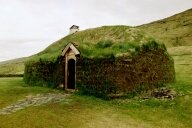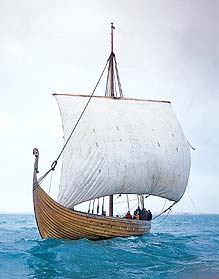Vikings

The Viking Age
Vikings found Iceland on there way to Faro islands. They must have catch a storm and drifted of the way. Long after man had spread to every corner of Europe, Iceland remained out of his reach. Early navigators may have drifted there and even lived to tell the tale; some such memory may lie behind the "Island of Thule", shown by ancient geographers. The first certain discoverers of Iceland were Irish monks who, in the style of St. Brendan, tested their faith by undertaking perilous ocean voyages. Perhaps the conspicuous migrations of Icelandic nesting birds across Ireland suggested to them the existence of land across the ocean. At the beginning of the "Viking Age," c. 800 AD, the Irish knew how to get to Iceland and back and some monks had spent considerable time in that empty country. There is no evidence of any permanent settlement, however, or family migration from Ireland to Iceland, nor did Irish strains of sheep or other farm animals survive in Iceland. Its settlement was left to the Norse.

The Viking Ship replica "Icelander"
During the 9th century, Scandinavian seaborne warriors - the Vikings - preyed upon much of Western Europe, especially the British Isles. In places they also settled down as war lords, traders, or simply peasants. Norwegian Vikings extended their activities southwards from earlier settlements in Shetland and Orkney, temporarily controlling parts of Scotland and Ireland. They also ventured further into the ocean and settled the Faroes.
Perhaps the Norwegian seafarers learnt from the Irish about the existence of Iceland. They may also, as later Icelandic tradition maintains, have stumbled upon it while accidentally by-passing the Faroes. Their navigational skills depended on landmarks or such signs as sea birds, whales and high clouds which might indicate the presence of land far beyond the horizon. On the high seas the sun was their compass, its height at noon indicating the latitude. Once lost they had no means of establishing how far west they had gone. Navigation to the Faroes, therefore, was bound to result in the discovery of Iceland, as, in turn, the Icelanders could not help discovering Greenland, and sailing to Greenland naturally involved the discovery of the American mainland. These navigational limitations made it simpler to follow a straight east-west route between Iceland (or Greenland) and Norway than the shorter but more oblique route between Iceland and the British Isles.
Once discovered, a country larger than Ireland or Scotland, rich in fish, seals and birds and with half of its area covered with vegetation, could not remain empty for long. The archaeological record shows that Iceland was being rapidly settled around 900. The flora adapted to the sudden impact of man and his grazing animals. Dwellings, graves and artefacts were of Scandinavian or Norwegian types, also known from Norse settlements in the British Isles. Two to four centuries later, Icelandic scholars and saga writers recorded a rich tradition about the settlement of the country. Families were traced to a Scandinavian, mainly Norwegian, origin, and the length of recorded genealogies would in most cases fit a settlement period centred on c. 900. Often the emigration of a Norwegian ancestor is explained in terms of a conflict with King Harald Finehair, who reportedly subdued all of Norway and established a national dynasty over the heads of a variety of regional petty rulers. The tendency of the historical tradition to exaggerate the wealth, power and high birth of the original settlers would require correspondingly potent reasons for such important people to emigrate, thus making the "royal conflict" a plausible standard explanation.
A number of settlers reportedly came from Norse colonies in the British Isles - Ireland, Scotland and the Scottish islands - where the Vikings, significantly, were suffering serious setbacks at the time. These Norsemen would have mixed with the Celtic and Pictish population, taking local wives, hiring local servants, acquiring slaves of local origin. Thus the Celts and Picts presumably made up a significant part of the ancestry of the Icelanders. That element, however, would have been more or less integrated with the Norse before the emigration to Iceland. It has thus left few traces in the archaeological record, nor has it contributed more than a handful of words to the Icelandic language, which was a Scandinavian dialect, more or less identical with the Viking Age Norse spoken in Western Norway, the Faroes, Shetland, Orkney, etc.
Vikings

